Abstract
Simulation results from two advanced CA based crowd dynamics models, namely Social Distances Model and Bonds Floor Field Model, are investigated using experimental data. Two experiments regarding pedestrian egress from simple network of rooms with multiple consecutive bottlenecks were conducted in Prague and Krakow. Simulation results comparison is the basis for discussion about models properties.
Access this chapter
Tax calculation will be finalised at checkout
Purchases are for personal use only
Notes
- 1.
Typical cells in CA models are 40\(\,\times \,\)40 cm.
References
Bandini, S., Federici, M.L., Vizzari, G.: Situated cellular agents approach to crowd modeling and simulation. Cybern. Syst. 38(7), 729–753 (2007)
Bukáček, M., Hrabák, P., Krbálek, M.: Cellular model of pedestrian dynamics with adaptive time span. In: Wyrzykowski, R., Dongarra, J., Karczewski, K., Waśniewski, J. (eds.) PPAM 2013, Part II. LNCS, vol. 8385, pp. 669–678. Springer, Heidelberg (2014)
Burstedde, C., Klauck, K., Schadschneider, A., Zittartz, J.: Simulation of pedestrian dynamics using a two-dimensional cellular automaton. Phys. A Stat. Mech. Appl. 295(3–4), 507–525 (2001)
Hrabák, P., Bukáček, M.: Influence of agents heterogeneity in cellular model of evacuation Submitted to Journal of Computational Science. arXiv:1604.08226 [cs.MA]
Hrabák, P., Bukáček, M., Krbálek, M.: Cellular model of room evacuation based on occupancy and movement prediction: comparison with experimental study. J. Cell. Automata 8(5–6), 383–393 (2013)
Lubaś, R., Porzycki, J., Wąs, J., Mycek, M.: Validation and verification of CA-based pedestrian dynamics models. J. Cell. Automata 11(4), 285–298 (2016)
Nishinari, K., Kirchner, A., Namazi, A., Schadschneider, A.: Extended floor field CA model for evacuation dynamics. IEICE Trans. Inf. Syst. E87–D, 726–732 (2004)
Porzycki, J., Mycek, M., Lubaś, R., Wąs, J.: Pedestrian spatial self-organization according to its nearest neighbor position. Transp. Res. Procedia 2, 201–206 (2014). http://www.sciencedirect.com/science/article/pii/S2352146514000696. The Conference on Pedestrian and Evacuation Dynamics 2014 (PED 2014), pp. 22–24, Delft, The Netherlands (October 2014)
Schadschneider, A., Chowdhury, D., Nishinari, K.: Stochastic Transport in Complex Systems: From Molecules to Vehicles. Elsevier Science B.V., Amsterdam (2010)
Vizzari, G., Manenti, L.: An agent-based model for pedestrian and group dynamics: experimental and real-world scenarios. In: van der Hoek, W., Padgham, L., Conitzer, V., Winikoff, M. (eds.) AAMAS, pp. 1341–1342. IFAAMAS (2012)
Wąs, J., Gudowski, B., Matuszyk, P.J.: New cellular automata model of pedestrian representation. In: El Yacoubi, S., Chopard, B., Bandini, S. (eds.) ACRI 2006. LNCS, vol. 4173, pp. 724–727. Springer, Heidelberg (2006)
Wąs, J., Lubaś, R.: Adapting Social Distances model for mass evacuation simulation. J. Cell. Automata 8, 395–405 (2013)
Wąs, J., Lubaś, R.: Towards realistic and effective agent-based models of crowd dynamics. Neurocomputing 146, 199–209 (2014)
Acknowledgements
This work was supported by the Czech Science Foundation under grant GA15-15049S. Further support was provided by the CTU grant SGS15/214/OHK4/ 3T/14. This work was also supported by AGH University of Science and Technology, contract No. 11.11.120.859.
Author information
Authors and Affiliations
Corresponding author
Editor information
Editors and Affiliations
Rights and permissions
Copyright information
© 2016 Springer International Publishing Switzerland
About this paper
Cite this paper
Hrabák, P., Porzycki, J., Bukáček, M., Lubaś, R., Wąs, J. (2016). Advanced CA Crowd Models of Multiple Consecutive Bottlenecks. In: El Yacoubi, S., Wąs, J., Bandini, S. (eds) Cellular Automata. ACRI 2016. Lecture Notes in Computer Science(), vol 9863. Springer, Cham. https://doi.org/10.1007/978-3-319-44365-2_39
Download citation
DOI: https://doi.org/10.1007/978-3-319-44365-2_39
Published:
Publisher Name: Springer, Cham
Print ISBN: 978-3-319-44364-5
Online ISBN: 978-3-319-44365-2
eBook Packages: Computer ScienceComputer Science (R0)

